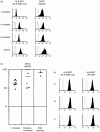Enterobacterial infection modulates major histocompatibility complex class I expression on mononuclear cells
- PMID: 10447763
- PMCID: PMC2326857
- DOI: 10.1046/j.1365-2567.1999.00803.x
Enterobacterial infection modulates major histocompatibility complex class I expression on mononuclear cells
Abstract
Major histocompatibility complex (MHC) class I expression is reduced in several viral infections, but it is not known whether the same happens during infections caused by intracellular enterobacteria. In this study, the expression of MHC class I antigens on peripheral blood mononuclear cells (PBMC) from 16 patients with Salmonella, Yersinia, or Klebsiella infection was investigated. During or after the acute infection, the expression of MHC class I antigens was markedly decreased in eight patients, all with genotype HLA-B27, and six out of eight with reactive arthritis (ReA). A significant decrease of monomorphic MHC class I was found in three patients, of HLA-B27 in eight (P<0.05) and of HLA-A2 in two. However, patients negative for the HLA-B27 genotype, or healthy HLA-B27-positive individuals, did not have a significant decrease of MHC class I antigens. During the decreased expression on the cell surface, intracellular retention of MHC class I antigens was observed, whereas HLA-B27 mRNA levels did not vary significantly. This is the first evidence that enterobacterial infection may down-regulate expression of MHC class I molecules in vivo and that down-regulation is predominant in patients with the HLA-B27 genotype.
Figures






Similar articles
-
Expression of MHC class II molecules on human monocytes is regulated independently from each other after phagocytosis of bacteria.Scand J Immunol. 1996 Jan;43(1):39-46. doi: 10.1046/j.1365-3083.1996.d01-3.x. Scand J Immunol. 1996. PMID: 8560195
-
HLA-B27-restricted cytotoxic T lymphocyte responses to arthritogenic enterobacteria or self-antigens are dominated by closely related TCRBV gene segments. A study in patients with reactive arthritis.Scand J Immunol. 1996 Jan;43(1):101-8. doi: 10.1046/j.1365-3083.1996.d01-16.x. Scand J Immunol. 1996. PMID: 8560188
-
Modification of disease outcome in Salmonella-infected patients by HLA-B27.Arthritis Rheum. 2000 Jul;43(7):1527-34. doi: 10.1002/1529-0131(200007)43:7<1527::AID-ANR17>3.0.CO;2-G. Arthritis Rheum. 2000. PMID: 10902756
-
Role of enterobacteria and HLA-B27 in spondyloarthropathies: studies with transgenic mice.Ann Rheum Dis. 1990 Jun;49 Suppl 1:426-33. Ann Rheum Dis. 1990. PMID: 2115764 Review.
-
Enterobacteria in reactive arthritis: Yersinia, Shigella, and Salmonella.Rev Rhum Engl Ed. 1999 Jan 30;66(1 Suppl):14S-18S; discussion 19S. Rev Rhum Engl Ed. 1999. PMID: 10063518 Review. No abstract available.
Cited by
-
Endosomal processing for antigen presentation mediated by CD1 and Class I major histocompatibility complex: roads to display or destruction.Immunology. 2009 Jun;127(2):163-70. doi: 10.1111/j.1365-2567.2009.03078.x. Immunology. 2009. PMID: 19476512 Free PMC article. Review.
-
Microbes as Master Immunomodulators: Immunopathology, Cancer and Personalized Immunotherapies.Front Cell Dev Biol. 2020 Jan 23;7:362. doi: 10.3389/fcell.2019.00362. eCollection 2019. Front Cell Dev Biol. 2020. PMID: 32039196 Free PMC article. Review.
-
Insights into the Role of Infection in the Spondyloarthropathies.Curr Rheumatol Rep. 2001 Oct;3(5):428-34. doi: 10.1007/s11926-996-0014-6. Curr Rheumatol Rep. 2001. PMID: 11564375 Review.
-
The role of infection in the pathogenesis of spondyloarthropathies with special reference to human leukocyte antigen-B27.Curr Rheumatol Rep. 2002 Dec;4(6):518-24. doi: 10.1007/s11926-002-0060-7. Curr Rheumatol Rep. 2002. PMID: 12427368 Review.
-
Streptokinase promotes development of dipeptidyl peptidase IV (CD26) autoantibodies after fibrinolytic therapy in myocardial infarction patients.Clin Diagn Lab Immunol. 2002 Nov;9(6):1253-9. doi: 10.1128/cdli.9.6.1253-1259.2002. Clin Diagn Lab Immunol. 2002. PMID: 12414758 Free PMC article.
References
-
- Garrido F, Ruiz-Cabello F, Cabrera T, et al. Implications for immunosurveillance of altered HLA class I phenotypes in human tumours. Immunol Today. 1997;18:89. - PubMed
-
- Andersson M, Pääbo S, Nilsson T, et al. Impaired intracellular transport of class I MHC antigens as a possible means for adenoviruses to evade immune surveillance. Cell. 1985;43:215. - PubMed
-
- Hill AB, Barnett BC, McMichael AJ, et al. HLA class I molecules are not transported to the cell surface in cells infected with herpes simplex virus types 1 and 2. J Immunol. 1994;152:2736. - PubMed
-
- Ploegh HL. Viral strategies of immune evasion. Science. 1998;280:248. - PubMed
-
- Sieper J, Braun J. Pathogenesis of spondylarthropathies. Persistent antigen, autoimmunity, or both? Arthritis Rheum. 1995;38:1547. - PubMed
Publication types
MeSH terms
Substances
LinkOut - more resources
Full Text Sources
Research Materials

